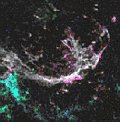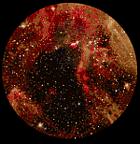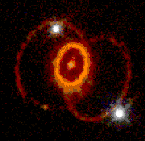

A star can be as massive as 100 times that of the Sun. What is the destiny for these really massive stars? The initial stages of evolution are similiar for all stars but in stars with masses greater than about 10 solar masses the core can reach a temperature high enough to lead to the fusion of heavier and heavier elements. Atoms as heavy as Iron can be produced in this way: heavier elements cannot be formed in stellar cores. |

At this point, the pressure in the stellar core is not sufficient to resist gravity and the core collapses and the outer layers of the star in a violent supernova explosion. This event is one of the most luminous in a galaxy -- so much so that a supernova can easily outshine that of its parent galaxy. |

Supernovae are more luminous and stay bright longer than a novae. There are two different types of supernovae; type I occur in binary systems in which a white dwarf accreates enough matter to push its mass over a certain limit and type II supernovae are the explosions of massive stars. Some supernovae leave behind a rotating neutron star, called a pulsar (pulsating radio sources). Astronomers have reported that it's probable that some pulsars are accompanied by planets. These planets would certainly not be suitable for life since the pulsar emits most of its energy as an intense stellar wind. |
|
Last modified 9th August 1999 Sarah Amandusson www_astro@mssl.ucl.ac.uk |